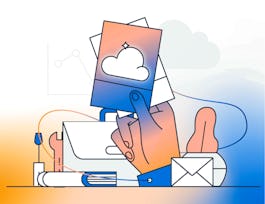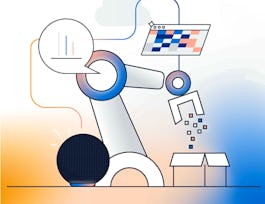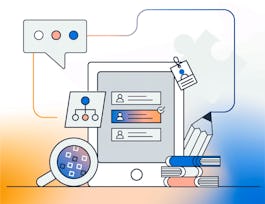This course gives you a thorough introduction to the python programming language. You'll start by learning the definition of python, its history, semantics, and how it works. The first week concludes by writing a python script to solve a problem. In Week 2, you'll learn about Serverless Architectures and understand the differences between microservices, service-oriented and monolith architectures. You'll build a microservices architecture by learning how to use the following tools: AWS Lambda, Amazon API Gateway, and Cloud9. It's then time to go deep with AWS Databases. You'll see Amazon RDS and Amazon DynamoDB in action, visualizing the important role they play in developing applications in python. The course's final week will cover application integration services. Amazon's Simple Notification Service (SQS), Simple Queue Service (SQS), and EventBridge take center stage as important “glue” components for scalable, cloud-based applications. You'll close the course with a hands-on project, writing some code to use some hardcoded data to write to dynamodb and then convert that into a lambda function.

Developing Applications in Python on AWS
This course is part of AWS Cloud Technology Consultant Professional Certificate
Taught in English
Some content may not be translated


Instructors: Morgan Willis
Top Instructor
3,335 already enrolled
Included with 
Course
(39 reviews)
What you'll learn
Introductory level Python programming and Python packages
Explain the different roles in an organization building software
Details to know

Add to your LinkedIn profile
5 quizzes, 2 assignments
Course
(39 reviews)
See how employees at top companies are mastering in-demand skills

Build your Cloud Computing expertise
- Learn new concepts from industry experts
- Gain a foundational understanding of a subject or tool
- Develop job-relevant skills with hands-on projects
- Earn a shareable career certificate from Amazon Web Services


Earn a career certificate
Add this credential to your LinkedIn profile, resume, or CV
Share it on social media and in your performance review

There are 4 modules in this course
This module starts with how to develop applications in a team. An application engineer doesn’t work alone, and you learn how an engineer interacts with roles such as architects, product managers, quality assurance (QA), support, and DevOps teams. Next, you learn the basics of Python programming. The goal is to get you to the level where you can read and understand some basic Python code. If you already know a programming language, many of the features of Python will look similar to the programming languages you already know.
What's included
12 videos10 readings1 quiz1 assignment2 plugins
This module focuses on software architecture. You learn about AWS Lambda as a home for your application code. You also investigate three different types of application architecture: microservices architecture, monolithic architecture, and service-oriented architecture. You walk through a conceptual ecommerce application, and compare how to build an application based on each architecture type. Next, you learn how to expose your application logic as an application programming interface (API). In a lab environment, you deploy a Lambda function and an Amazon API Gateway API by using the AWS Serverless Application Model (AWS SAM).
What's included
7 videos2 readings1 quiz1 app item
In this module, you learn about using a database for your application data. You explore both relational databases with Amazon Relational Database service (Amazon RDS), and NoSQL databases with Amazon DynamoDB. You learn about the differences between relational databases and NoSQL databases, and when you would choose one type of database instead of the other. You also explore different examples of how to access relational databases and DynamoDB from a Python application.
What's included
6 videos1 reading1 quiz1 app item
This module introduces you to another way that you can integrate your applications: by using messaging and event buses. You learn how to integrate applications by creating a topic in Amazon Simple Notification Service (Amazon SNS) and adding multiple subscribing applications. You then explore how an application sends messages to an Amazon Simple Queue Service (Amazon SQS) queue, and how consumer applications retrieve messages from that queue. Next, you investigate event-driven applications, which are another type of application architecture. You learn how an application can be designed as a series of both events, and applications that create and respond to these events. Finally, you learn how an application can receive, filter, transform, route, and deliver events by using Amazon EventBridge.
What's included
6 videos2 readings2 quizzes1 assignment2 app items1 plugin
Instructors

Offered by
Recommended if you're interested in Cloud Computing

Amazon Web Services

Amazon Web Services

Amazon Web Services

Amazon Web Services
Why people choose Coursera for their career




Learner reviews
Showing 3 of 39
39 reviews
- 5 stars
76.92%
- 4 stars
7.69%
- 3 stars
7.69%
- 2 stars
2.56%
- 1 star
5.12%
New to Cloud Computing? Start here.

Open new doors with Coursera Plus
Unlimited access to 7,000+ world-class courses, hands-on projects, and job-ready certificate programs - all included in your subscription
Advance your career with an online degree
Earn a degree from world-class universities - 100% online
Join over 3,400 global companies that choose Coursera for Business
Upskill your employees to excel in the digital economy
Frequently asked questions
Access to lectures and assignments depends on your type of enrollment. If you take a course in audit mode, you will be able to see most course materials for free. To access graded assignments and to earn a Certificate, you will need to purchase the Certificate experience, during or after your audit. If you don't see the audit option:
The course may not offer an audit option. You can try a Free Trial instead, or apply for Financial Aid.
The course may offer 'Full Course, No Certificate' instead. This option lets you see all course materials, submit required assessments, and get a final grade. This also means that you will not be able to purchase a Certificate experience.
When you enroll in the course, you get access to all of the courses in the Certificate, and you earn a certificate when you complete the work. Your electronic Certificate will be added to your Accomplishments page - from there, you can print your Certificate or add it to your LinkedIn profile. If you only want to read and view the course content, you can audit the course for free.
If you subscribed, you get a 7-day free trial during which you can cancel at no penalty. After that, we don’t give refunds, but you can cancel your subscription at any time. See our full refund policy.